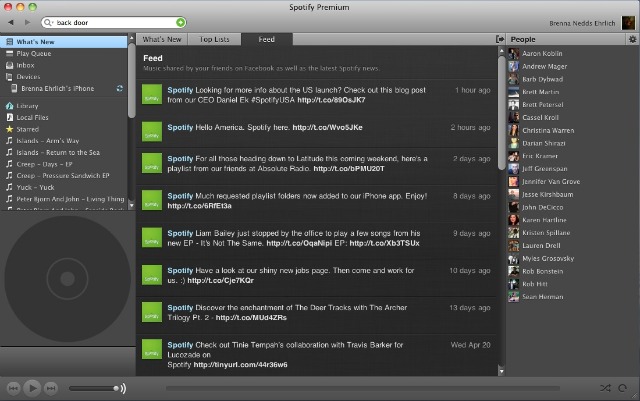In my previous post, I explained Why Spotify’s Social Strategy is Fundamentally Flawed. There’s an obvious distinction between Actively and Passively shared updates, and Spotify’s use of the latter has negatively affected both its growth and value.
Facebook made the same mistake when games such as Zynga’s ‘Farmville’ encouraged passively shared updates. Feeds were filled with spam, forcing Facebook to fix the issue by prioritising friends updates that we actively engaged with.
But how can Spotify change their approach?
Building In Active Sharing
A mechanism to encourage active sharing needs to be built into the core of Spotify, not bolted on top.
A Facebook/Twitter style feed of friends and tastemaker recommendations is the obvious template to follow. It’ll allow us to tell anyone who wants to listen what our favourite song of the week is, AND WHY. Spotify have been toying with this idea for some time, but never implemented it properly. The below feed was replaced by the current feed that appears in the bottom right of the player.
We’ll explain our playlists, share our favourite lyrics, and recall musical memories with friends. We’ll explain the latest trends, rediscover old ones, and rationalise why ‘Tonight’ by New Kids On The Block wasn’t an embarrassing first single to have bought, and why it’s an overlooked piece of pop history (at least, I will).
Some may choose to fill niche interests – create feeds that solely analyse a song’s chords, or list the technical details of the instruments used. If you find something interesting, share it and you’ll probably find others who agree.
The possibilities are endless.
Identifying and Encouraging Curators
But not everyone will want to share content in this way. The 80-20 rule (aka Pareto’s principle) applied here implies that 20% of users will generate 80% of the content. These 20%, the curators, are hugely influential – they start trends, filter out the shit, and break artists. Identify who they are, and treat them well. Encourage them to contribute, and don’t force them to compete with passively shared updates for attention.
These curators aren’t just our (annoyingly vocal) friends. Artists are of course curators themselves, and will be keen to actively share the inspirations behind their music. Tastemakers are also key, and are already active online, from small-time bloggers to Pitchfork and NME. Rival service MOG – soon to be relaunched by Beats – syndicated this content (reviews, features) and imported it in to MOG, tagging it with the associated song/album/artist. It was clunky and poorly implemented, but a similar system is key if active sharing is to reach its potential.
The challenge will be paying websites for their content. A cut of the ad revenue they generate, or an expanded version of today’s affiliate links, may be ideas worth exploring. But one thing is clear, Spotify needs fans to spread the virtues of music if it is to increase the value of the url.
How This Affects Growth
Optimising growth is the central problem addressed by the ideas above. Returning to the growth framework from the previous essay – Acquisition, Activation, Engagement, Virality – it was the latter two that active sharing addresses.
A feed of recommendations from our friends, trusted tastemakers, and our favoured blogs & websites will guide us through our journey, and remove the choice paralysis that currently exists (engagement).
Shared music will be more valuable, special and will spread faster both within Spotify and beyond (virality). An ecosystem of content will be available with each song, to suit whatever we’re into.
And if all this works, we’ll laugh at the idea that mp3’s were all we ever wanted.


 Farewell
Farewell  Part 1 : Why Spotify’s Social Strategy is Fundamentally Flawed
Part 1 : Why Spotify’s Social Strategy is Fundamentally Flawed  How Google Play can forge a new Music Industry
How Google Play can forge a new Music Industry  Gotye - Making Mirrors
Gotye - Making Mirrors  Why Streaming Can Make Music Special Again
Why Streaming Can Make Music Special Again  Saint Simon by The Shins
Saint Simon by The Shins  How Understanding Choice Will Bring Music Streaming To The Masses
How Understanding Choice Will Bring Music Streaming To The Masses 


Good news ! a fineoffers
To qualify click on the link below
http://bit.ly/2HR7Pml